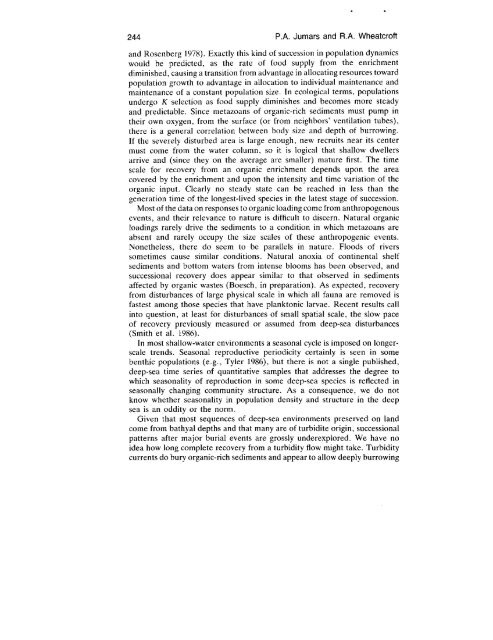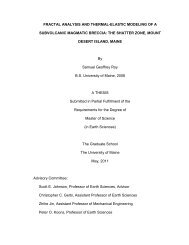Responses of Benthos to Changing Food Quality and Quantity, with ...
Responses of Benthos to Changing Food Quality and Quantity, with ...
Responses of Benthos to Changing Food Quality and Quantity, with ...
You also want an ePaper? Increase the reach of your titles
YUMPU automatically turns print PDFs into web optimized ePapers that Google loves.
244 P .A . Jumars <strong>and</strong> R .A . Wheatcr<strong>of</strong>t<br />
<strong>and</strong> Rosenberg 1978) . Exactly this kind <strong>of</strong> succession in population dynamics<br />
would be predicted, as the rate <strong>of</strong> food supply from the enrichment<br />
diminished, causing a transition from advantage in allocating resources <strong>to</strong>ward<br />
population growth <strong>to</strong> advantage in allocation <strong>to</strong> individual maintenance <strong>and</strong><br />
maintenance <strong>of</strong> a constant population size . In ecological terms, populations<br />
undergo K selection as food supply diminishes <strong>and</strong> becomes more steady<br />
<strong>and</strong> predictable . Since metazoans <strong>of</strong> organic-rich sediments must pump in<br />
their own oxygen, from the surface (or from neighbors' ventilation tubes),<br />
there is a general correlation between body size <strong>and</strong> depth <strong>of</strong> burrowing .<br />
If the severely disturbed area is large enough, new recruits near its center<br />
must come from the water column, so it is logical that shallow dwellers<br />
arrive <strong>and</strong> (since they on the average are smaller) mature first . The time<br />
scale for recovery from an organic enrichment depends upon the area<br />
covered by the enrichment <strong>and</strong> upon the intensity <strong>and</strong> time variation <strong>of</strong> the<br />
organic input . Clearly no steady state can be reached in less than the<br />
generation time <strong>of</strong> the longest-lived species in the latest stage <strong>of</strong> succession .<br />
Most <strong>of</strong> the data on responses <strong>to</strong> organic loading come from anthropogenous<br />
events, <strong>and</strong> their relevance <strong>to</strong> nature is difficult <strong>to</strong> discern . Natural organic<br />
loadings rarely drive the sediments <strong>to</strong> a condition in which metazoans are<br />
absent <strong>and</strong> rarely occupy the size scales <strong>of</strong> these anthropogenic events .<br />
Nonetheless, there do seem <strong>to</strong> be parallels in nature . Floods <strong>of</strong> rivers<br />
sometimes cause similar conditions . Natural anoxia <strong>of</strong> continental shelf<br />
sediments <strong>and</strong> bot<strong>to</strong>m waters from intense blooms has been observed, <strong>and</strong><br />
successional recovery does appear similar <strong>to</strong> that observed in sediments<br />
affected by organic wastes (Boesch, in preparation) . As expected, recovery<br />
from disturbances <strong>of</strong> large physical scale in which all fauna are removed is<br />
fastest among those species that have plank<strong>to</strong>nic larvae . Recent results call<br />
in<strong>to</strong> question, at least for disturbances <strong>of</strong> small spatial scale, the slow pace<br />
<strong>of</strong> recovery previously measured or assumed from deep-sea disturbances<br />
(Smith et al . 1986) .<br />
In most shallow-water environments a seasonal cycle is imposed on longerscale<br />
trends . Seasonal reproductive periodicity certainly is seen in some<br />
benthic populations (e .g ., Tyler 1986), but there is not a single published,<br />
deep-sea time series <strong>of</strong> quantitative samples that addresses the degree <strong>to</strong><br />
which seasonality <strong>of</strong> reproduction in some deep-sea species is reflected in<br />
seasonally changing community structure . As a consequence, we do not<br />
know whether seasonality in population density <strong>and</strong> structure in the deep<br />
sea is an oddity or the norm .<br />
Given that most sequences <strong>of</strong> deep-sea environments preserved on l<strong>and</strong><br />
come from bathyal depths <strong>and</strong> that many are <strong>of</strong> turbidite origin, successional<br />
patterns after major burial events are grossly underexplored . We have no<br />
idea how long complete recovery from a turbidity flow might take . Turbidity<br />
currents do bury organic-rich sediments <strong>and</strong> appear <strong>to</strong> allow deeply burrowing
















